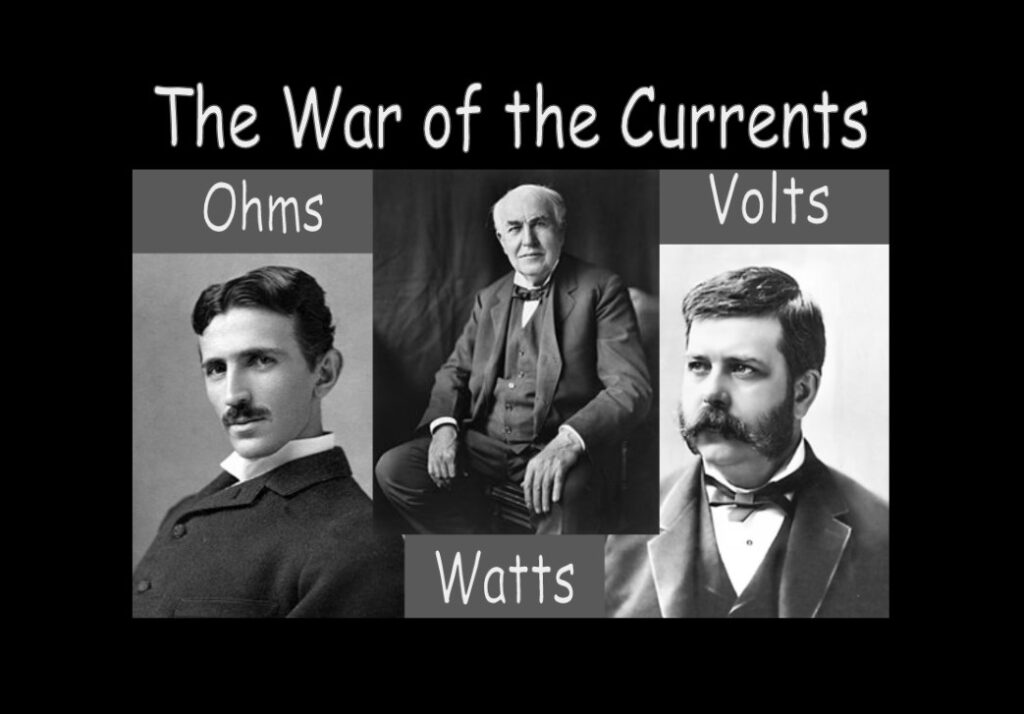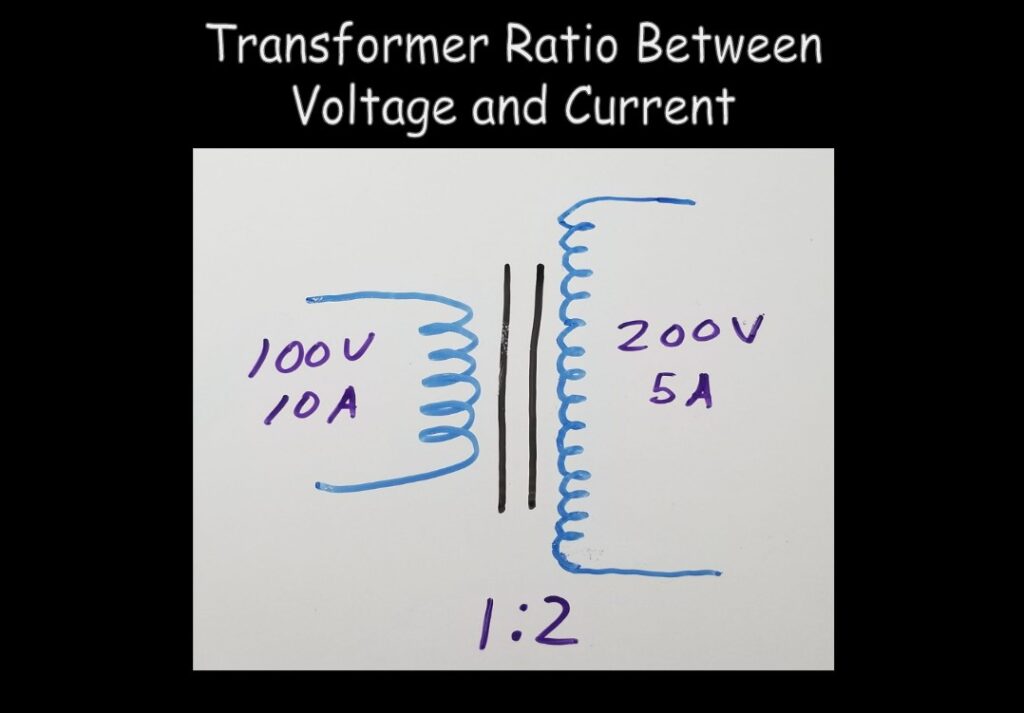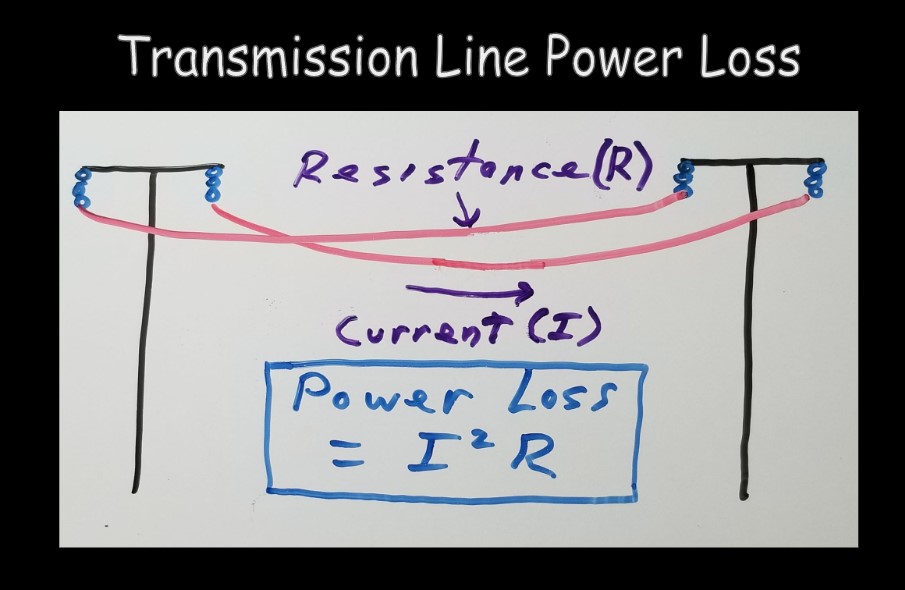
AC power in the home has been around since near the end of the 19th century. Almost all of world’s power distribution infrastructure is based on it. In fact, there was a time when practicality no other technology would work. It had superior transmission efficiency and was compatible with emerging industrial-age motor technology.
However, based on current technology, every device, appliance, and mechanical system in the home, can be designed operate on DC power. In fact, today’s actual need for 50Hz and 60Hz AC residential power is based solely on its backwards compatibility with legacy technology. As such, I predict that AC power in the home will be phased out in near future.
Thomas Edison vs. George Westinghouse
In 1882, Thomas Edison established the first electric utility, based on low voltage DC power distribution. When Nikola Tesla worked for Edison, he tried to convince him of AC technology’s advantages. Edison wasn’t interested. Soon after, Telsa quit his job, patented his AC technology, and sold it to George Westinghouse. In 1886, Westinghouse implemented Tesla’s AC voltage system. It could readily transmit power at high voltage over long distances with drastically higher efficiency than Edison’s. A few years later, Edison proclaimed that the AC system was hazardous, inferior to his DC transmission method, and that it infringed on his patents.
Safety concerns mounted with Westinghouse’s high voltage AC system due to the many associated accidents and fatalities. This substantiated Edison’s claims that it was unsafe system relative to his lower-voltage DC infrastructure.
Why AC Won
Ultimately, Edison’s system proved inadequate and impractical for for large-scale infrastructure, and lost out to Westinghouse’s. But why?
AC Voltage was Easy to Step up and Step Down
Tesla was really on to something. His AC generation and distribution inventions would make the difference between being able to transmit power for 100’s of miles instead of only a few miles.
AC, by its nature induces magnetic fields around the current-carrying wires. That magnetic flux then induces current through other nearby wiring. When two coils of wire are coupled by a ferromagnetic core like iron, the AC voltage across one winding can be reproduced across the other winding. The ratio of voltage from one to the other proportionally depends on how many turns are in the respective windings. This means that you can step a voltage up to just about any value you want, within reason. Of course, energy isn’t free, so there’s a trade off. When you double the voltage, you cut the current in half. But you’ll see why that’s actually a good thing.

Power Losses at Low Voltage vs. High Voltage
Why step up the voltage? What is the advantage? The crux of the matter is about current. Simply put, the lower the current, the exponentially lower the power loss. The higher the voltage, the lower the needed current for a given amount of power transmission. By doubling the voltage, you cut the current in half, and reduce the power loss by a factor of four – and so on.

Westinghouse’s System vs. Edison’s
The amount of power delivered (or lost) by a utility transmission line has to do with the power equation, which is I²R, where I is current and R is line resistance. Let’s look at a simple example using the voltages that each stakeholder proposed. Westinghouse’s early systems transmitted power at 6000 volts AC, which was stepped down to useable voltage in homes in businesses. Conversely, Edison’s system ran on 110 volts DC.
Suppose you want to transmit 2,000 watts of power a distance of one mile. That one-mile transmission line because of its return path, makes a two-mile round trip and has a total resistance of say 3 ohms, which corresponds to AWG#2 aluminum wire.
Westinghouse’s System Power Loss and Delivery
In terms of voltage and current, power = VxI. So I=P/V. In order for Westinghouse’s system to transmit 2,000 watts at 6000 volts, it only needed 2000W/6000V = 0.33 amps of current flowing through the line. The power lost in heat dissipation from the power lines was again I²R, or 0.33² x 3 ohms = 0.33 watts, meaning that 1999.67 watts was available at the final destination – and with almost no voltage loss. This is an efficiency of 99.98%. Very impressive.
Edison’s System Power Loss and Delivery
On the other hand, Edison’s DC system only used 110V. So it would need 2000W/110V = 18.18 amps flowing through the lines to deliver 2000 watts to the load. The amount of power lost (as heat) in the 3 ohm power line would be substantial. Using the power equation, I²R = 18.18² x 3 ohms = 992 watts. This means that Edison would need to raise the voltage at the origin by 54.4v for a total of 164.4v in order to get 110v to the destination. He would thus need to generate 2992w for a 2000w delivery – which equates to a 67% efficiency. So 33% of the generated power was wasted as heat. You can see that this severely limited the distance in which Edson’s system could transmit power. In fact, Edison’s early systems were limited to distribution distances of around one mile.
Conclusion on Delivery Methods
Based on the example, you can see that Westinghouse’s system delivered almost 100% of the power, whereas Edison’s low voltage DC system delivered only 67%. The relative differences between the two technologies are far more profound when increasing the transmission distance to 10 or 100 miles. In fact, at 18 amps, Edison’s system would struggle to transmit over just a few miles.
In contrast, Westinghouse’s system would transmit 100 miles and only lose a negligible 33.3 watts – still delivering over 98% of the original power. This is why Westinghouse’s high voltage AC system was considered vastly superior, and ultimately won out in what was dubbed the “war of the currents”.
AC Power was Ideal for Induction Motors
During this war of infrastructures, the industrial age was in full swing. As a result, another selling point for AC was its compatibility with induction motors. These motors would quickly supplant steam engines in industry. They would also ubiquitously find their place in the home. AC current was very conducive to creating rotating magnetic fields in the motor’s stators. DC, on the other hand, required mechanical commutators and brushes that were inherently unreliable, created sparks, and required continuous maintenance.
DC Power in the Home
Why would AC power in the home go away? Relative to DC power, getting AC power to the home is expensive and inefficient. When appliances, HVAC systems, clocks, and consumer electronics relied on AC for proper functionality, there was no need to question its existence. Now, though, the primary reliance on AC is its backwards compatibility with legacy technology. As time passes, there will be little to no need for it.
Most modern power supplies rectify low frequency AC into DC voltage before stepping down to low voltage DC. High power resistive loads in dryers, ovens, and HVAC systems won’t notice the difference between AC and DC voltage. BLDC motor technology is quickly replacing induction motors in appliances. The -4000v bias voltage for microwave magnetrons can be, and is already being provided by DC-based inverter technology. Solar panels, which output DC voltage, are becoming more common – and must currently be inverted to work with AC technology. DC power can be stored by batteries. By definition, AC cannot. In essence, the only thing that supports AC in the home is legacy technology. If you couple that with AC power’s relatively high cost and inefficiency, the pressure to push AC out of the picture will ultimately prevail.
In fact, I envision safer very low voltage (12v – 24v) satellite DC sub-systems being used in the extremities of the home, that can be backed-up via commonly available storage batteries. These could be tapped into during power outages, renewable energy off-times, or even peak grid usage hours – and be used to power low-current small refrigerators, laptops, lighting, and entertainment electronics – all of which would continue to work during an outage. When power is restored, such a system would seamlessly continue working, while their batteries are being recharged.
One of the biggest points in favor of all-DC homes though, is to make way for an all-DC infrastructure that will drastically increase large-scale transmission efficiency, and reduce cost and complexity.
High Voltage DC Infrastructure
What will be left is the fact that the current AC infrastructure is so vast and deeply rooted. However, stepping up and stepping down low frequency AC is costly. Huge transformers are required to prevent magnetic core saturation at such low frequencies. Also, the voltage conversion is not 100% efficient. Some power is lost in the “step-up” and “step-down” process. There are also significant reactive power losses associated with high voltage AC power transmission.
With DC transmission, DC-DC converters will be used for stepping up and stepping down the voltage. They can achieve very high efficiently rates. As well, they operate in the kHz range – greatly reducing transformer size and cost. Reactive power losses (and power factor considerations) associated with AC transmission will be a thing of the past. Phase differences between grids will no longer exist, making inter-grid connectivity much simpler. Less transmission line conductors will be used because there will be no need to support three-phase power. Many high voltage DC transmission lines already exist – even greater than 1MV. They are simpler, less inexpensive to build, and waste less energy.
So who was Right?
Thomas Edison envisioned DC power distribution, but overlooked its limited scalability. Based on available technology, his system was forced to be low-voltage. As mentioned previously, the lower the voltage, the exponentially lower the efficiency of long-distance power distribution. At the time, there was no practical technology available for stepping up (or down) DC voltage. Had there been, his DC infrastructure would have make more sense. Westinghouse’s and Tesla’s technology was the clear winner at the time. AC voltage was easy to step-up, and fully compatible with increasingly popular induction motor technology.
Today though, DC up-conversion and down-conversion technology is readily available – even on a large scale. Once it is stepped down for use in the home it can be more readily stored. Relatively inefficient induction motors, which rely on 50Hz or 60Hz AC voltage, are being supplanted by BLDC technology in almost every imaginable application. High power resistive loads such as heating elements are 100% compatible with DC. Linear power supplies which rely on AC voltage, are actually quite uncommon in new products. In fact, AC is converted to DC anyway, for SMPS (switched mode power supplies), which are now ubiquitous in the home (phone chargers, laptops, appliances, etc).
Given recent consumer electronics technological advancement, AC power in the home could be significantly phased out in the next several decades. The present high voltage infrastructure will take much longer though. In the interim, DC substations can rectify the AC voltage at large scale for distribution to high-tech DC communities. Ultimately, a DC infrastructure will simplify distribution, be more cost-effective, and will nullify inter-grid phase differences. So today’s “war of the currents” won’t be between two rival companies, but between legacy infrastructure and rapidly emerging technologies.
In the end, both Edison and Tesla were right. To Edison’s credit, DC power distribution was less complex, void of reactive power considerations, and easier to store. As for Westinghouse (and Tesla), high voltage distribution was the answer to “deal-breaking” line losses – which in practicality, could only be done using AC voltage at the time. Ironically for Edison, in the near future, all of those advantages, albeit incrementally, might finally come to fruition in the form of a primarily DC topology. TC
“Diverting 10 min/day of social media time towards learning something new, is 5 hours of newfound monthly knowledge.” – SM
To DONATE to the Tech Circuit – CLICK HERE
Alphabetical Links to all Tech Circuit Articles and Blogs – CLICK HERE
Links to all Tech Circuit Cheat Sheets/Field References for Appliance/HVAC Techs – CLICK HERE
For additional electrical and electronics learning material for field techs, visit our homepage at http://www.TechCircuit.org or our Facebook group at https://www.facebook.com/groups/746823709133603, or our YouTube Channel
at https://www.youtube.com/c/TheTechCircuit
We are a participant in the Amazon Services LLC Associates Program, an affiliate advertising program designed to provide a means for us to earn fees by linking to Amazon.com
